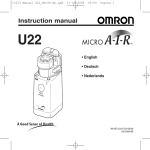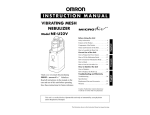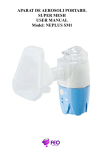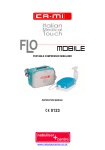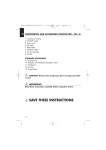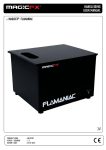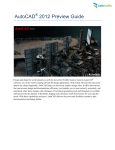Download Omron Nebulizer NE-U03V User's Manual
Transcript
R INSTRUCTION MANUAL PORTABLE NEBULIZER MODEL NE-U03V TABLE OF CONTENTS Introduction………………………………………………………………………2 Important Safeguards ……………………………………………………………3 Know Your Unit …………………………………………………………………4 Cautions-Warnings ……………………………………………………………5, 6 Unit Assembly …………………………………………………………………7 Operating Instructions …………………………………………………………8 Unit Disassembly & Maintenance ………………………………………………9 Cleaning ………………………………………………………………………10 Mesh Cleaning …………………………………………………………………11 Storage …………………………………………………………………………12 Battery Operation ………………………………………………………………13 Troubleshooting Guide …………………………………………………………14 Available Accessories …………………………………………………………15 Specifications …………………………………………………………………16 Common Questions About The MicroAir …………………………………17, 18 Warranty ………………………………………………………………………20 INTRODUCTION Thank you for buying the Omron A.I.R.S. Model NE-U03V MicroAir® Nebulizer. The MicroAir changes liquid medicine into an aerosol form. This change is done using vibration. The Micro-Air was designed with your needs in mind and weighs less than one pound. The Micro-Air runs with a standard AC adapter or with 4 "AA" batteries (batteries not included). The Micro-Air silently delivers medication continuously or intermittently. The Micro-Air medication cup holds 5-ml. The LED feature indicates "power ON" and "battery status". The Micro-Air can be used with mask or mouthpiece for your convenience and comfort. The Micro-Air is completely adaptable to any requirement with its full range of accessories. Using your Micro-Air for any reason other than its intended purpose will void the warranty. 2 IMPORTANT SAFEGUARDS When using electrical products, especially when children are present, basic safety precautions should always be followed, including: READ ALL INSTRUCTIONS BEFORE USING DANGER - To reduce the risk of electrocution: 1. Always unplug this product immediately after using. 2. Do not use this product while bathing. 3. Do not place or store this product in a place where it can fall or be pulled into a tub or sink. 4. Do not place or drop into water or any liquid. 5. Do not reach for this product if it has fallen into water. Unplug immediately. DANGER - To reduce the risk of burns, electrocution, fire, or injury to persons: 1. This product should never be left unattended when plugged in. 2. Close supervision is necessary when this product is used by, on, or near children or compromised individuals. 3. Use this product only for its intended use as described in this manual. Do not use attachments not recommended by the manufacturer. 4. Never operate this product if it has a damaged cord or plug, if it is not working properly, if it has been dropped or damaged, or if it has fallen into water. Return the product to OMRON Healthcare, Inc. for service. 5. Keep the cord away from heated surfaces. 6. Never use this product while sleeping or drowsy. 7. Do not use this product where other aerosol products are being used, or where oxygen is being administered. 8. Unplug this product before filling. Do not overfill. SAVE THESE INSTRUCTIONS CAUTION: Operate this unit only as instructed by your healthcare provider and/or respiratory therapist. Thoroughly read and understand the information contained in these instructions on the use and care of this unit before operating. Save these instructions for future reference. 3 KNOW YOUR UNIT Mouthpiece Mask Mesh Cap (Extra Cap Included) Vibration Horn Unit Cover Medication Cup On/Off Button MicroAir Unit Rinse Bottle AC Adapter* Battery Lid AC Jack * The shape of the plug may vary from country to country. 4 CAUTIONS - WARNINGS 1. WARNING The most delicate part of the unit is the mesh cap.NEVER touch the mesh cap directly. Follow the cleaning instructions exactly to avoid damaging the mesh cap. (See page 10 for cleaning instructions.) 2. WARNING Before using the MicroAir for the first time, or after storing it for an extended period, be sure to clean and sterilize all necessary parts as explained on page 10. 3. WARNING NEVER submerge or wet the AC power unit or cord. An electrical shock may result. 4. WARNING NEVER touch the vibration horn when in operation. 5. WARNING Always clean and rinse the medication cup after each use. Never leave the cleaning solution in the medication cup or mouthpiece (see page 10). 6. WARNING NEVER operate while driving a car or boat. 7. WARNING Do not force the bottom of the battery compartment onto the main unit. Doing so may cause damage. 8. WARNING Be careful when attaching and removing the medication cup. Damage to the unit may occur and lead to medication leakage. 5 CAUTIONS - WARNINGS 9. WARNING Do not submerge the unit in water to prevent damage. 10. WARNING Fill the medication cup before using the unit. Do not shake the unit during use. 11. CAUTION Assure that the proper adapter is used for connection to any electrical outlet to prevent damage to the unit or injury. 12. CAUTION Check the medication cup and mouthpiece weekly. Replace as necessary. 13. CAUTION Handle the mess cap with care to prevent breakage. 14. CAUTION The medication cup holds 5 ml. Do not overfill. 6 UNIT ASSEMBLY How to Assemble A. Clean and sterilize all unit parts before the first use or after a long storage period. B. Fill the medication cup before plugging in the unit and turning on the power. 2. Attach the medication cup to the back of the unit. Push the medication cup vertically until a click is heard. 1. Remove the cover by gently pushing in an upward direction. 3. The mesh cap is attached as follows: A. Place the cap position indicator onto the unit turning counterclockwise to 10 o’clock B. Then turn the cap clockwise to 12 o’clock until a click is heard to assure proper attachment. 4. Attached the mask or mouthpiece directly over the mesh cap unit a click is heard. Remember to handle the mesh cap with care to prevent breakage. 5. Attach the AC adapter plug to the "AC Adapter Jack" for use with electrical current.The unit can also be battery powered by using 4 "AA" batteries as described on page 13. How to Fill Medication Cup Be sure that all parts are clean before filling medication cup. Place the prescribed medication directly into the medication cup. Never use more than 5 ml of solution. 7 OPERATING INSTRUCTIONS 1. Before Operating Make sure all parts are mounted properly. Check to fill the medication up to correct level of 5 ml. 2. Plug In Connect the adapter into a standard AC 120V outlet. Four (4) "AA" alkaline batteries may also be used to run the unit. 3. Nebulizing Start the unit by pressing the ON/OFF button. Continuous aerosol is controlled by holding the button down for four (4) seconds. Press the ON/OFF button again to turn off the unit. NOTES: A. The green operation light will be on during continuous operation. B. A blinking green light during battery power means that the batteries are low and need to be replaced as soon as possible. 4. Nebulization Rate The unit has been pre-set to nebulize at an average rate of 0.25 ml per minute. Nebulization rates may vary due to different medications. Check with your healthcare provider or pharmacist regarding your medication. 8 UNIT DISASSEMBLY & MAINTENANCE NOTE: The mesh cap may be damaged by hardened medication that is left in the vibration horn effecting how the unit nebulizes. The following are maintenance recommendations after each use to keep your unit working at its best level. 1. NOTE: Be sure that the unit is turned OFF. Remove the medication cup and dispose of any remaining medications. 2. Be sure to nebulize all medication from the unit. The medication cup needs to be removed while the unit is on to remove all medication that might be in the mesh cap or transducer. The unit will no longer provide any aerosol when these parts are completely empty. NOTE: The lack of any misting will occur with a high pitched sound when all medication has been nebulized. Quickly turn the unit off when this sound is heard it shows that there is no more medication in the unit. 3. Pour a mixture of one part vinegar and three parts distilled water into the medication cup after each use. Nebulize the mixture for about 45 to 60 seconds. Remove the medication cup and run the unit until it can no longer mist. Turn the unit off at this point. NOTE: Make sure that there is no medication left on the mesh cap or horn that can dry and cause damage or breakage to the mesh cap when removed from the unit. Place 2-3 drops of the water/vinegar mixture onto the mesh cap surface when dried medication is noted. Nebulize distilled water from the medication cup for at least 30 seconds. We recommend that a small bottle of the water/vinegar mixture be kept with your unit at all times for proper cleaning. 9 CLEANING Be sure unit is OFF and the power cord is disconnected before cleaning. Nebulizer Parts and Casing (EXCEPT MESH CAP) 1. There are several ways to clean the medication cup and mouthpiece. A. Soak parts in a mixture of one part vinegar and three parts distilled water for 30 minutes B. Use a commercially available disinfectant C. Parts may also be boiled for 10 minutes. D. All parts must be rinsed thoroughly and air dried. 2. Clean the main unit casing using a cloth moistened with water and a few drops of non-abrasive cleanser. Wipe dry with a soft cloth. ■ NEVER clean with benzene, thinner or a flammable chemical 3. The horn can be cleaned with vinegar. Moisten a cloth with vinegar for surface cleaning. Mix one part vinegar and three parts distilled water to be run through for 45-60 seconds for internal horn cleaning. 10 MESH CLEANING NOTE: The mesh cap is the most delicate part of the MicroAir. It is important not to directly touch the mesh cap. Follow the cleaning instructions to avoid damaging the mesh cap and keep it in good condition. A. After Every Cleaning 1. Remove the medication cup and rinse with water after turning the unit OFF. 2. Nebulize all medication remaining in the mesh cap and transducer after removing the medication cup. Turn the unit off when the aerosol stops. 3. Nebulize a mixture of one part vinegar and three parts distilled water for 45 to 60 seconds through the medication cup. 4. Remove the medication cup and leave the unit ON. Keep the unit running until all of the mist stops. Turn the unit OFF and replace the unit cover. B. Daily Cleaning 1. Follow the steps listed above. 2. Soak the mesh cap in water/vinegar solution for 10 to 15 minutes after removing from the unit. 3. Swish the meshcap in a blow of warm water. DO NOT rinse mesh cap directly under a faucet as this will cause damage. 4. Replace mesh cap back onto nebulizer and turn the unit on until the aerosol mist stops. Quickly turn the unit OFF. Replace the unit cover. C. Weekly Cleaning For Difficult Medications 1. 2. 3. 4. 5. Follow the steps listed above in section A. Place mesh cap in a microwavable cup with one cup of distilled water. Microwave on high for 3 minutes Soak mesh cap in warm water for 30 minutes Replace mesh cap back on nebulizer and run until the aerosol mist stops. Turn the unit OFF. Replace the unit cover. 11 STORAGE 1. Completely dry all cleaned and sterilized parts. Mesh Cap Attach the mesh cap to the unit as describe in the operating instructions. Handle the mesh cap with care as it is very fragile and may be easily damaged. Medication Cup Attach the medication cup to the unit as described in the operating instructions. Unit Cover Attach cover to the unit by sliding the cover down until it clicks into place. Mouthpiece or Mask The mouthpiece or mask can be stored in the carrying case or a plastic bag. AC Adapter Store in a carrying case. 2. Store the unit in a carrying case when it is not in use. Keep in cool, dry area. Keep away from direct sunlight, high temperatures, high humidity, dust, water, possible vibration or shocks. 104°F 50°F 12 BATTERY OPERATION Using Batteries 1. Turn the unit upside down. The battery lid will lift off by pressing down towards the arrows. 2. Insert four (4) "AA" alkaline batteries matching the polarities to the marks( + or - ) inside the unit. 3. Replace the battery lid by pressing downward until it clicks into place as shown on the right. NOTE: The batteries will need to be replaced if either of these conditions occur: A. When the green operation light blinks during continuous use B. The unit shuts off while being battery operated. Replace all four (4) batteries at the same time. Unit failure may occur if batteries are not used or inserted correctly. Use the following guidelines for unit maintenance. 1. Remove the batteries before storing the unit for a long time. The unit can be damaged from battery leaks if stored together. 2. Alkaline batteries are recommended for best performance. 13 TROUBLE SHOOTING GUIDE (check before sending for service*) Check the following if your unit should fail during operation. You can also refer to the pages of this manual for complete instructions. Symptom Continuous operation button does not light up. • With AC adapter in use Continuous operation button does not light up. • With battery No nebulization. Check Remedy ➀ Is the AC adapter plugged into 120V electrical outlet? Insert plug. ➁ Is the AC adapter connected to the unit? Connect correctly. ➀ Are the batteries inserted correctly? Wipe the battery connectors on the battery cover with vinegar. Place batteries correctly. ➁ Are the batteries charged? Change all batteries. ➂ Are alkaline batteries inserted? Use all alkaline batteries. ➀ Is there medication in the medication cup? Fill medication cup. Turn unit on. ➁ See above for power Low nebulization rate. ➂ Is the mesh cap in working order? Replace mesh cap. ➀ Is the medication cup broken? Replace medication cup if necessary. ➁ Check the medication level in the cup. Add medication if necessary. ➂ Is the battery working? Check battery. ➃ Is the vibration horn clean? Switch to AC operation. Clean the vibration horn. ➄ Is the mesh cap broken? Replace cap. * Do not try to repair unit - no parts of the unit are user serviceable. Return unit to authorized OMRON dealer. 14 AVAILABLE ACCESSORIES A full range of accessories make the MicroAir adjustable to virtually every requirement. Medication Cups (MODEL #U03-7) Aerosol Mask (MODEL #U03-2) A 5 ml Medication Cup Plastic Aerosol Mask Mouthpiece (MODEL #U03-3) Mesh Cap (MODEL #U03-4) Plastic Mouthpiece AC Adapter (MODEL #U03-5) Battery Lid (MODEL #U03-9) AC Adapter 120v, 60 Hz Unit Cover (MODEL #U03-8) Carrying Case (MODEL #U03-10) Pediatric Mask (MODEL #U03-11) Rinse Bottle (MODEL #U1006) Soft Silicone Mask 15 SPECIFICATIONS* Power Source: AC 120v 60 Hz Power Consumption: Approximately 1.2 w Vibration Frequency: Approximately 65 KHz Nebulization Rate: 0.25 ml/min ±0.05 Particle Size Range: 6 ~ 9.5 microns Medication Cup: Maximum capacity 5 ml Dimensions: 67 x 32 x 165 mm Weight: 148 grams, approximately 5.2 oz Battery: 4 “AA” alkaline (not included) Battery Life: Approximately 300 Minutes * Specifications subject to change without notice. NOTE: This equipment has been tested and found to comply with the limits pursuant to part 18 of the FCC Rules. These limits are designed to provide reasonable protection against harmful interference in a residential installation. This equipment generates, uses, and can radiate radio frequency energy and, if not installed and used in accordance with the instructions, may cause harmful interference to radio communications. However, there is no guarantee that interference will not occur in a particular installation. If this equipment does cause harmful interference to radio or television reception, which can be determined by turning the equipment off and on, the user is encouraged to try to correct the interference by one or more of the following measures: ■ Reorient or relocate the receiving antenna. ■ Increase the separation between the equipment and receiver. ■ Connect the equipment into an outlet on a circuit different from that to which the receiver is connected. ■ Consult the dealer or an experienced radio/TV technician for help. 16 COMMON QUESTIONS ABOUT THE MICROAIR Q. A. Can I use any type of double “AA” batteries in the MicroAir? We recommend that alkaline batteries be used for best performance. Q. A. How long will a set of batteries operate the MicroAir? The expected battery life is 300 minutes of operation. Q. A. What other sources of power can the MicroAir use? The MicroAir can operate from either AC power or battery. Q. A. How often should I clean the MicroAir? You must clean the MicroAir after each use. Guidelines for handling an cleaning the mesh cap are detailed on page 11. Q. A. How do I clean the MicroAir? See pages 10-11 for cleaning instructions. Q. If the mesh cap has very small holes, is it likely to clog during use? The mesh cap will operate without clogging with proper cleaning after each use as described in this manual. A. Q. A. What should I do if my mesh clogs during operation? Turn the unit OFF. Follow the instructions to remove the mesh cap. Repeat the cleaning instructions. Replace the cap and restart the unit. Q. A. How do I clean the internal part of the horn? Mix 1 part vinegar and 3 parts distilled water. Operate the MicroAir with 2 ml of this solution to maintain working order. Q. Should I keep all parts of the MicroAir on the unit at all times? Yes. The unit needs to be taken apart for cleaning and reassembled for storage. It is recommended to keep the unit and any accessories in a carrying case for convenience and protection. You are less likely to break or lose a part if the unit remains assembled. A. 17 COMMON QUESTIONS ABOUT THE MICROAIR Q. A. Will the mesh break easily? The mesh is like all small delicate parts that can be broken if not gently handled. It is important that after cleaning the mesh that it be placed back on the unit. This will protect the mesh from damage while the unit is not being used. Be sure to replace the unit cover after use for added protection. Q. How much medication is left at the end of treatment in the medication cup? There should only be a few drops of medication at remaining in the cup after a treatment. Medication that remains in the cup is a result of the method by which the unit operates that can not deliver all medication. A. Q. A. Q. A. After using the MicroAir there is some medication inside the mouthpiece. Is this normal? Yes. Up to .02 ml can remain in the mouthpiece from condensation that results from the aerosol process. Should I take my treatment with the MicroAir set on continuous flow or should I use the intermittent method? Consult with your healthcare provider as to the type of delivery method of your medication. Q. A. When do I change the mesh? The mesh is projected to last up to 6 months with recommended cleaning and maintenance. However, if the mesh should break during use, you must replace it. Q. Under normal use, what changes will I see in the mesh when it needs to be replaced? The unit will start to "flood" the mesh during treatment and the aerosol product will stop. IF cleaning procedures on page 11 do not correct the flooding, the mesh cap should be replaced. A. Reminder: Daily mesh cap cleaning is essential to keep your Micro-Air working properly. See page 11 for mesh cap cleaning instructions. 18 TWO YEAR LIMITED WARRANTY Your Omron MicroAir Portable Nebulizer is warranted to the original retail purchaser to be free from defects in material and workmanship for a period of 2 years from the date of purchase. This warranty does not cover failures resulting from misuse, abuse, alteration of the Omron Nebulizer, use of improper components, or failure to comply with the operating instructions. This warranty does not include the disposable accessories. To make a warranty claim, return your Omron Nebulizer, freight prepaid and insured (or assume the risk of loss or damage during shipment) to OMRON HEALTHCARE, INC., 300 Lakeview Parkway, Vernon Hills, IL 60061, Attention: Service Department. All requests for warranty service should include the model number of your Omron Nebulizer, proof of purchase (including date of purchase), your phone number and the nature of your service request. OMRON will either repair or at its option replace free of charge any parts necessary to correct defects in material or workmanship covered by this limited warranty. THIS LIMITED WARRANTY IS IN LIEU OF ALL OTHER WARRANTIES, WHETHER ORAL, WRITTEN, EXPRESS OR IMPLIED. THERE ARE NO WARRANTIES OF MERCHANTABILITY OR FITNESS FOR A PARTICULAR PURPOSE, EXCEPT FOR THOSE IMPLIED WARRANTIES ARISING BY OPERATION OF LAW WHICH ARE LIMITED IN DURATION TO THE 2 YEAR TERM OF THIS WARRANTY. OMRON’S LIABILITY, WHETHER BASED ON CONTRACT, TORT, WARRANTY, STRICT LIABILITY, OR ANY OTHER THEORY, SHALL NOT EXCEED THE PRICE OF THE INDIVIDUAL OMRON NEBULIZER WHICH IS THE BASIS OF THE CLAIM. IN NO EVENT SHALL OMRON BE LIABLE FOR ANY LOSS OF PROFITS, FACILITIES, EQUIPMENT, OR OTHER INCIDENTAL, CONSEQUENTIAL, OR SPECIAL DAMAGES. Some states do not allow limitations on how long an implied warranty lasts, or allow the exclusion or limitation of incidental, consequential, or special damages, so the above limitations or exclusions may not apply to you. This warranty gives you specific legal rights. You may also have other rights which vary from state to state. LICENSED UNDER U.S. PAT. 4829419, 4942516, 4896260, 4531182, 4825364, 4686622, 4121284 4396976, 4371923, 4471385, 4120583, 4435732, 4672457, 4739396 19 R Distributed by OMRON HEALTHCARE, INC. 300 Lakeview Parkway Vernon Hills, Illinois 60061 Phone: 1-800-634-4350 www.omronhealthcare.com Copyright © OMRON HEALTHCARE, INC. NE-U03 INST Rev B OMRON uses recycled paper to help preserve our natural resources.




















